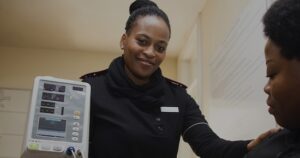When Mary stopped by her sister Sophia’s for coffee—at Sophia’s request— Sophia seemed surprised to see her. And Mary couldn’t help but notice that Sophia was wearing mismatched shoes. Sophia’s daughter noticed that her mother often forgot not only the names of her grandchildren, but that she even had grandchildren. Sophia’s family was seriously concerned about her forgetfulness. Was this just a normal part of growing old or could it be Alzheimer’s disease?
10 warning signs: Symptoms defined
The Alzheimer’s Association has developed a list of symptoms that might indicate Alzheimer’s disease. It’s important to remember that some of these symptoms also apply to other illnesses. If more than one symptom is noted, the affected person should see his or her physician for a complete exam.
- 1. Recent memory loss. Memory of events and information experienced within the last 30 minutes is affected early in the course of Alzheimer’s. This loss makes learning difficult.
- Difficulty performing familiar tasks. These include activities such as getting dressed, paying bills and meal preparation.
- Problems with language. People with Alzheimer’s may often have trouble expressing themselves. They may also have problems understanding speech.
- Disorientation in place and time. People with Alzheimer’s may get lost in familiar surroundings. They may also forget appointments and lose track of time.
- Poor or decreased judgment. Judgment may be impaired in everyday situations, such as deciding what clothes to wear, handling a problem at work or driving.
- Problems with abstract thinking. Examples would include being unable to define words or concepts and having problems dealing with numbers.
- Misplacing things. The person may lose things or put them away in odd places. For example, putting a watch in the refrigerator.
- Changes in mood or behavior. Rapid mood swings for no apparent reason and symptoms of anxiety, restlessness or agitation should be evaluated.
- Changes in personality. With Alzheimer’s, personality traits may become more evident or exaggerated. For example, a normally suspicious person may become outright paranoid.
- Loss of initiative. When it comes to activities, the person may appear passive and withdrawn, often requiring coaxing or prompting to become involved.
How could they tell? What are the symptoms?
There are a number of symptoms to watch for (see sidebar, “Symptoms Defined”). However, a person would have to show several symptoms before Alzheimer’s disease would even be considered. In addition, the majority of “suspicious” symptoms seen in the elderly are more likely to be due to a physical or emotional problem than to Alzheimer’s. There are more than 60 other disorders that have similar symptoms. It’s important to remember that Alzheimer’s develops very gradually. And, although forgetfulness is usually the earliest and most obvious symptom, a psychological problem—depression, irritability or anxiety—is often the real tip-off.
If you suspect Alzheimer’s
If a number of symptoms are noted, the first step is a visit to the family doctor. However, a referral to a neurologist or psychiatrist often is necessary for a complete evaluation. An evaluation will probably include a detailed medical history, a thorough physical and neurologic exam, and a complete psychological assessment. Laboratory tests will also be performed. These will probably include blood work, urinalysis, chest X-ray and a scan of the brain, such as magnetic resonance imaging (MRI).
A thorough evaluation is important because some conditions with symptoms similar to those of Alzheimer’s are treatable. Because there’s no diagnostic test for Alzheimer’s other than a brain biopsy or autopsy, a diagnosis is made only after other possible diseases are ruled out. This is often a lengthy process.
Just what is Alzheimer’s disease?
Alzheimer’s disease is actually just one of a group of disorders known as dementia—what used to be called senility. In Alzheimer’s, nerve cells in areas of the brain responsible for speech, thought, memory and reason die off. As the disease progresses, the person eventually loses the ability to carry out normal daily activities. Researchers have yet to determine what causes this disease, and currently, there’s no cure.
An estimated 4.5 million Americans are affected by Alzheimer’s, according to the Alzheimer’s Association. Although risk of the disease increases with age, it doesn’t only affect the very elderly—it can strike people in their 40s and 50s. It affects men and women equally, and occurs among all races and socioeconomic groups.
What next?
If a loved one is diagnosed with Alzheimer’s disease, it’s important to remember that you’re not alone. With the right information, planning and emotional support, you’ll be able to cope with this disease.
Convincing someone to see a doctor
According to the Alzheimer’s Association, your calm, uncritical attitude may help your loved one overcome his or her fear of getting medial help. Try suggesting a check-up for a physical symptom that the person is willing to acknowledge, such as headaches or vision trouble. Or, suggest scheduling an appointment to test for high blood pressure or diabetes.




















